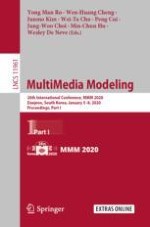The two-volume set LNCS 11961 and 11962 constitutes the thoroughly refereed proceedings of the 25th International Conference on MultiMedia Modeling, MMM 2020, held in Daejeon, South Korea, in January 2020.
Of the 171 submitted full research papers, 40 papers were selected for oral presentation and 46 for poster presentation; 28 special session papers were selected for oral presentation and 8 for poster presentation; in addition, 9 demonstration papers and 6 papers for the Video Browser Showdown 2020 were accepted. The papers of LNCS 11961 are organized in the following topical sections: audio and signal processing; coding and HVS; color processing and art; detection and classification; face; image processing; learning and knowledge representation; video processing; poster papers; the papers of LNCS 11962 are organized in the following topical sections: poster papers; AI-powered 3D vision; multimedia analytics: perspectives, tools and applications; multimedia datasets for repeatable experimentation; multi-modal affective computing of large-scale multimedia data; multimedia and multimodal analytics in the medical domain and pervasive environments; intelligent multimedia security; demo papers; and VBS papers.
